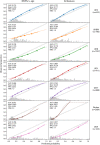Evaluation and improvement of the National Early Warning Score (NEWS2) for COVID-19: a multi-hospital study
- PMID: 33472631
- PMCID: PMC7817348
- DOI: 10.1186/s12916-020-01893-3
Evaluation and improvement of the National Early Warning Score (NEWS2) for COVID-19: a multi-hospital study
Abstract
Background: The National Early Warning Score (NEWS2) is currently recommended in the UK for the risk stratification of COVID-19 patients, but little is known about its ability to detect severe cases. We aimed to evaluate NEWS2 for the prediction of severe COVID-19 outcome and identify and validate a set of blood and physiological parameters routinely collected at hospital admission to improve upon the use of NEWS2 alone for medium-term risk stratification.
Methods: Training cohorts comprised 1276 patients admitted to King's College Hospital National Health Service (NHS) Foundation Trust with COVID-19 disease from 1 March to 30 April 2020. External validation cohorts included 6237 patients from five UK NHS Trusts (Guy's and St Thomas' Hospitals, University Hospitals Southampton, University Hospitals Bristol and Weston NHS Foundation Trust, University College London Hospitals, University Hospitals Birmingham), one hospital in Norway (Oslo University Hospital), and two hospitals in Wuhan, China (Wuhan Sixth Hospital and Taikang Tongji Hospital). The outcome was severe COVID-19 disease (transfer to intensive care unit (ICU) or death) at 14 days after hospital admission. Age, physiological measures, blood biomarkers, sex, ethnicity, and comorbidities (hypertension, diabetes, cardiovascular, respiratory and kidney diseases) measured at hospital admission were considered in the models.
Results: A baseline model of 'NEWS2 + age' had poor-to-moderate discrimination for severe COVID-19 infection at 14 days (area under receiver operating characteristic curve (AUC) in training cohort = 0.700, 95% confidence interval (CI) 0.680, 0.722; Brier score = 0.192, 95% CI 0.186, 0.197). A supplemented model adding eight routinely collected blood and physiological parameters (supplemental oxygen flow rate, urea, age, oxygen saturation, C-reactive protein, estimated glomerular filtration rate, neutrophil count, neutrophil/lymphocyte ratio) improved discrimination (AUC = 0.735; 95% CI 0.715, 0.757), and these improvements were replicated across seven UK and non-UK sites. However, there was evidence of miscalibration with the model tending to underestimate risks in most sites.
Conclusions: NEWS2 score had poor-to-moderate discrimination for medium-term COVID-19 outcome which raises questions about its use as a screening tool at hospital admission. Risk stratification was improved by including readily available blood and physiological parameters measured at hospital admission, but there was evidence of miscalibration in external sites. This highlights the need for a better understanding of the use of early warning scores for COVID.
Keywords: Blood parameters; COVID-19; NEWS2 score; Prediction model.
Conflict of interest statement
JTHT received research support and funding from InnovateUK, Bristol-Myers-Squibb, iRhythm Technologies, and holds shares < £5000 in Glaxo Smithkline and Biogen.
Figures



References
-
- WHO . WHO COVID-19 dashboard. 2020.
Publication types
MeSH terms
Grants and funding
- Health Data Research UK (HDRUK/CFC/01)/MRC_/Medical Research Council/United Kingdom
- 207511/Z/17/Z/WT_/Wellcome Trust/United Kingdom
- MR/R016372/1 for the King's College London MRC Skills Development Fellowship programme/MRC_/Medical Research Council/United Kingdom
- CH/1999001/11735/BHF_/British Heart Foundation/United Kingdom
- Rutherford Fellowship MR/S003991/1/MRC_/Medical Research Council/United Kingdom
- MR/R017751/1/MRC_/Medical Research Council/United Kingdom
- Clinical Training Fellowship (MR/R017751/1)/MRC_/Medical Research Council/United Kingdom
- WT_/Wellcome Trust/United Kingdom
- MR/S004149/2/MRC_/Medical Research Council/United Kingdom
- MC_PC_18029/MRC_/Medical Research Council/United Kingdom
- Health Data Research UK Grant (MR/S004149/1)/MRC_/Medical Research Council/United Kingdom
- MR/S00310X/1/MRC_/Medical Research Council/United Kingdom
LinkOut - more resources
Full Text Sources
Other Literature Sources
Medical
Research Materials
Miscellaneous

